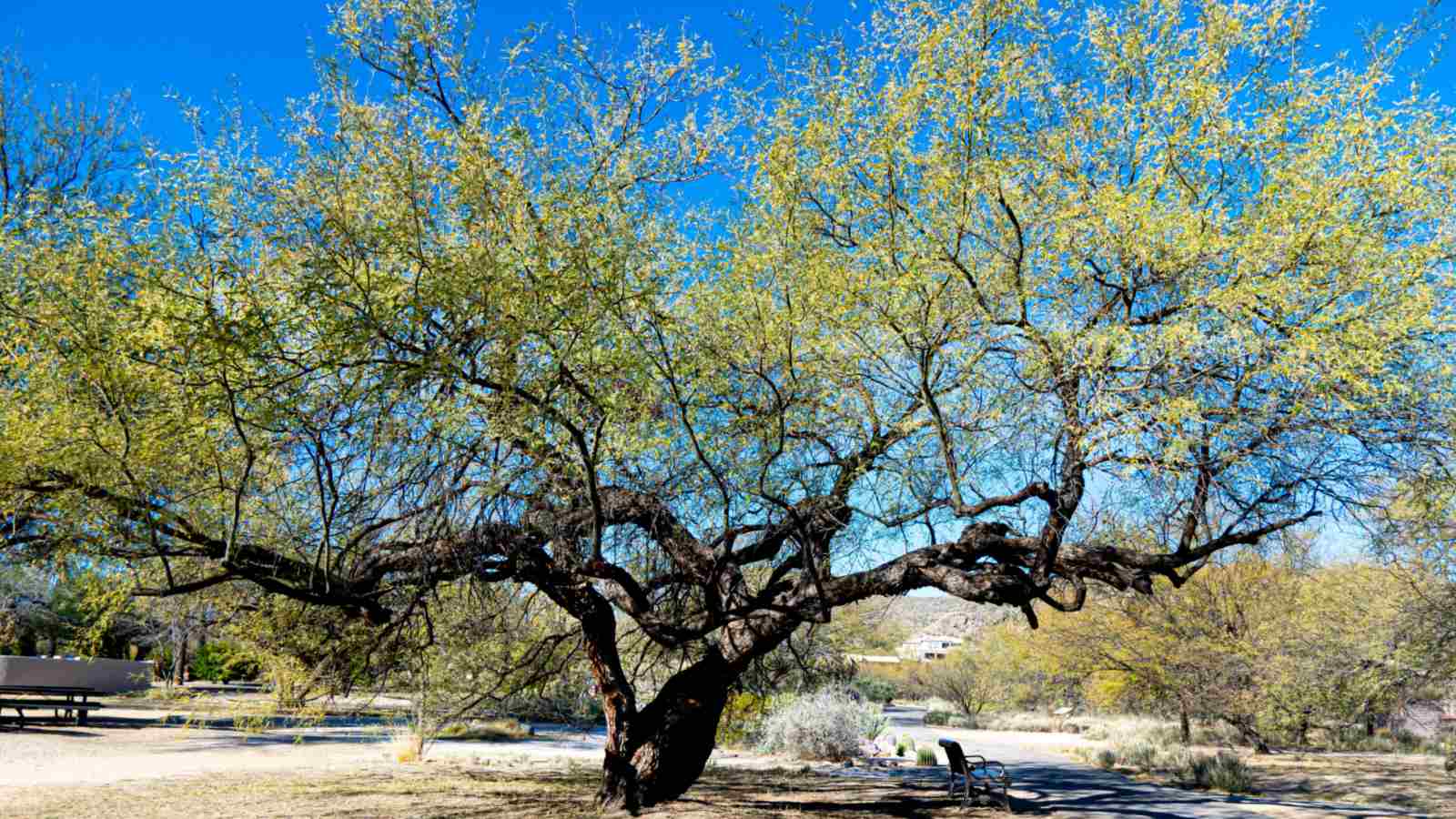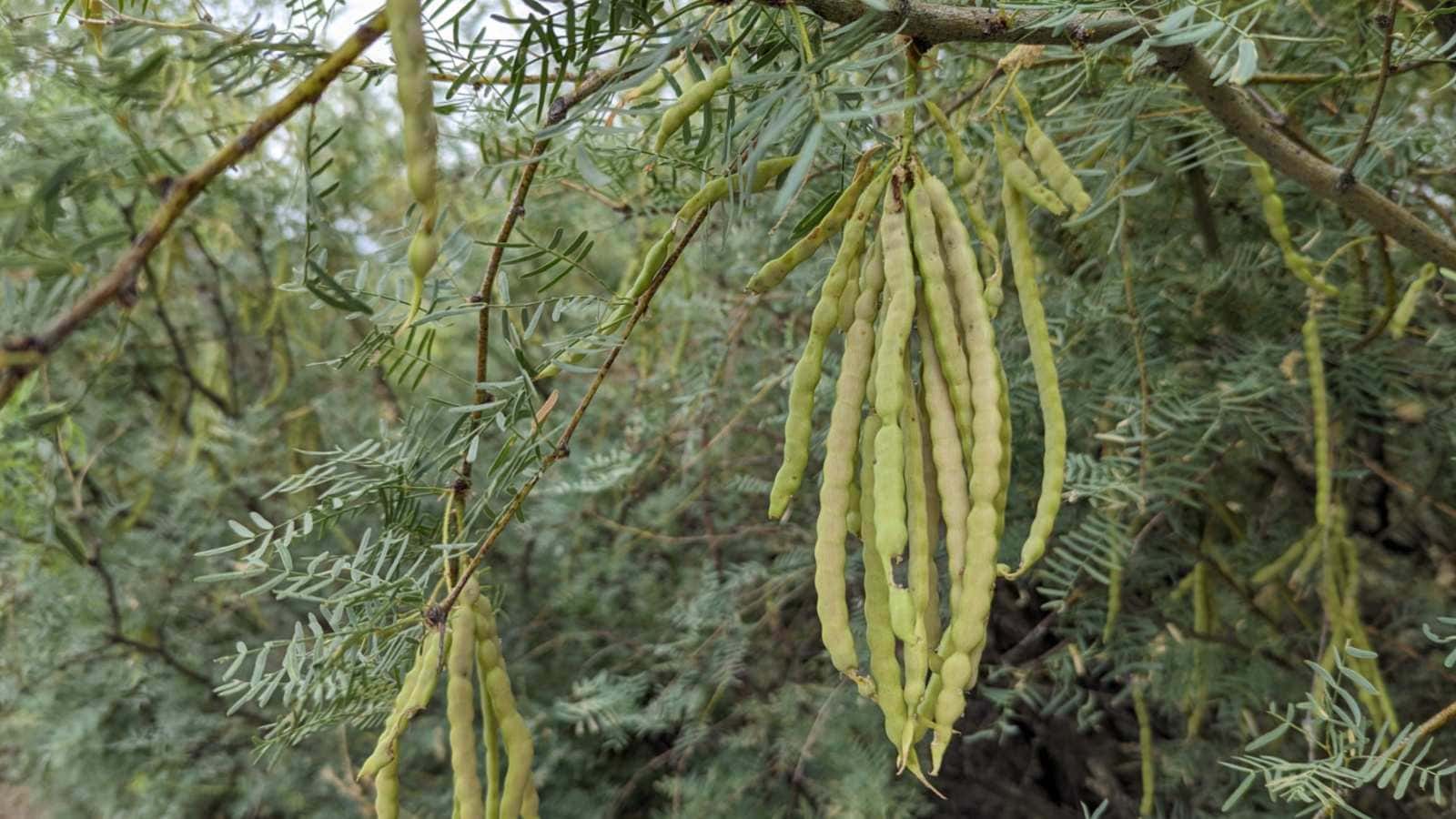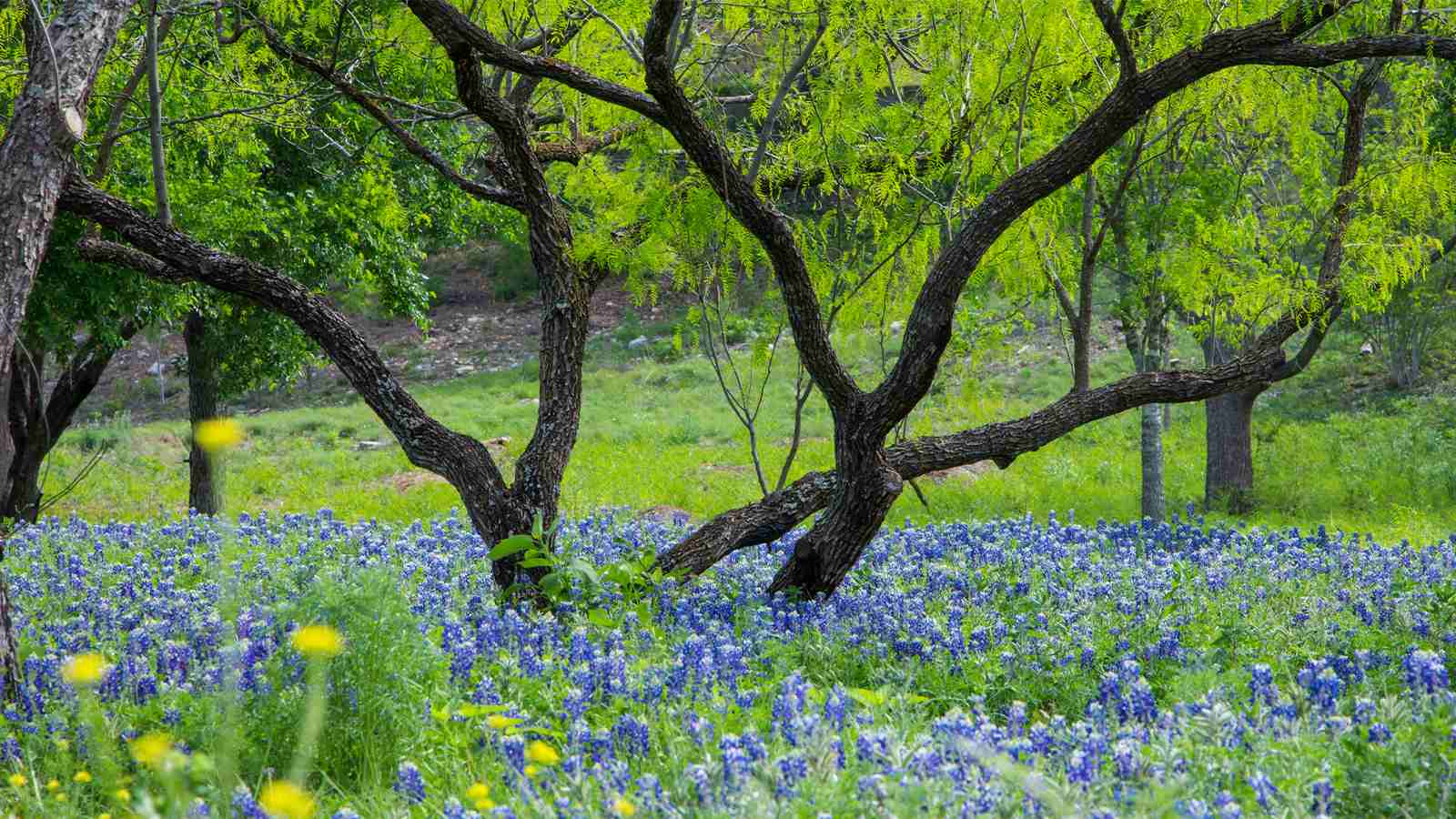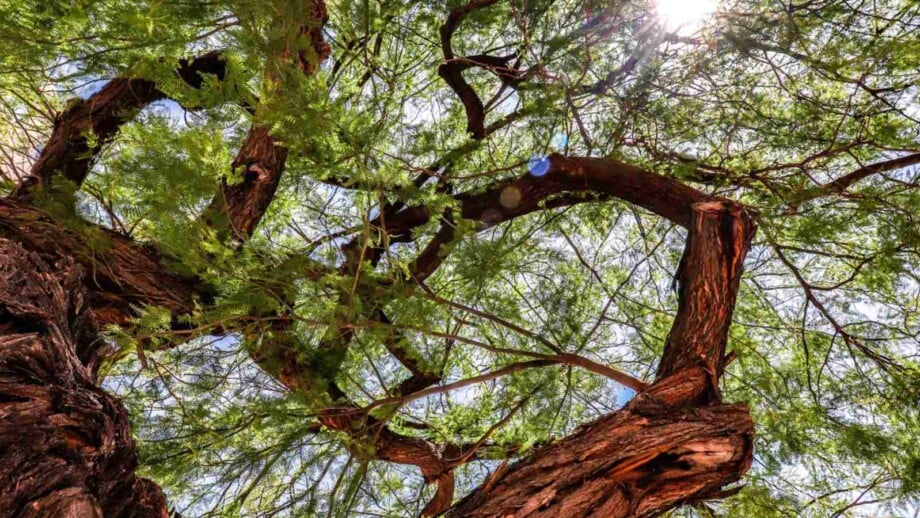Mesquite tree, scientifically known as Prosopis glandulosa, is a common sight in the warm and arid landscape of Texas and the southwestern United States. This small tree, belonging to the Fabaceae family, has adapted over time to thrive in the harsh conditions of the region, with its deep root systems and ability to withstand drought.
As a master gardener, I’ve always been intrigued by these trees. They’re known for their resilient nature and their valuable contributions to the ecosystem. They provide shade and shelter for wildlife, attract pollinators with their fragrant catkins, and offer a source of nutrition through their bean pods.
The mesquite’s economic and ecological importance is further underscored by its cultural significance to the Native Americans and early settlers of the southern United States.
These iconic trees are characterized by their distinctive bark, which is deeply furrowed and can range in color from gray to reddish-brown. The trunk of a mesquite tree is often gnarled and twisted, showcasing its ability to withstand harsh conditions. The leaves of the mesquite are made up of numerous small leaflets and are typically green, although some varieties may exhibit a bluish hue.
Mesquite trees produce long, bean-like pods that contain edible seeds. These pods, also known as mesquite beans, have long been used by indigenous people as a source of sustenance.

They can be ground into a nutritious flour, which has a naturally sweet and nutty flavor. Mesquite flour, popularized in recent years as a healthy and gluten-free alternative, is now sought after by chefs and health-conscious consumers alike.
Farmers and ranchers in Texas have traditionally viewed mesquite trees as a nuisance due to their robust growth and invasive tendencies. However, recent studies have shed light on the benefits of these trees, prompting a change in perspective.
In this article, I’ll go over everything you need to know about mesquite trees, along with the pros and cons of having them and the three most common types.
What are Mesquite Trees?
Mesquite trees, scientifically known as Prosopis spp., are a species of deciduous trees and shrubs that belong to the legume family.

They are native to North and South America and are renowned for their adaptability to a wide range of environments, from deserts to tropical climates. These trees can reach impressive heights of up to 30 feet and feature attractive, finely divided foliage.
One fascinating aspect of mesquite trees is their ability to survive in arid regions with limited water availability. Their deep root systems allow them to tap into underground water sources, making them highly resilient in drought conditions.
These trees have evolved over time to efficiently utilize water, and their leaves are adapted to minimize water loss through transpiration.
In addition to their remarkable adaptability, mesquite trees play a crucial role in the ecosystems they inhabit. They provide shade and shelter for various wildlife species, including birds, mammals, and insects.
The dense canopy of mesquite trees offers protection from the scorching sun, creating a microclimate that supports a diverse range of organisms.
While there are over 40 species of mesquite trees found worldwide, let’s look at the three most popular types:
Velvet Mesquite (Prosopis velutina)

Height: 30 to 50 feet
Spread: 30 to 50 feet
Growth rate: Medium
Where it Grows: Southern Arizona, Northern Mexico, Southwest
Bark: Thick, brown, rough
Shade: Dense
Leaves: Greenish-yellow leaflets
Flowers: Catkins
Thorns: Present on stem
The Velvet Mesquite, or Prosopis velutina, is no ordinary shrub or small tree. Native to the arid regions of the Southwest, particularly in Southern Arizona and Northern Mexico, it is part of the Fabaceae family.
What makes this tree special is its resilience. Even in the harshest of drought conditions, this mesquite tree can thrive, thanks to its extensive root systems that reach deep into the soil for water sustenance. It adds a unique character to any landscape with its bee-attracting catkins and edible, honey-sweet mesquite pods.
Gardeners should consider growing Velvet Mesquite because of their remarkable ability to thrive in dry climates. They produce a dense shade perfect for those hot summer days.
They do not require additional nitrogen as they can fix atmospheric nitrogen themselves. This means these mesquite trees can grow in poor soils where other trees may struggle.
Severe conditions do not dampen its growth; instead, these trees serve as a safe space for wildlife, particularly for birds who find shelter in its thorns.
Not just for its toughness, but its byproducts – the mesquite beans- can be ground into a healthy, gluten-free mesquite flour. The flexibility of this tree does not stop here as the dense hardwood, derived from its robust bark and trunk, is valued by carpenters and has been traditionally used by natives for making furniture and utensils.
All these reasons contribute to why the Velvet Mesquite tree would be a beneficial addition to your garden. This tree extends beyond the realm of just nature to find value in our homes.
Farmers in Texas, Australia, and even as far south as Chile know the importance of Mesquite trees like our Velvet Mesquite.
Honey Mesquite (Prosopis glandulosa)

Height: 15 to 40 feet
Spread: 15 to 40 feet
Growth rate: Fast
Where it Grows: Southern United States, Southwest, Southern Arizona, Northern Mexico
Bark: Rough, brownish-grey
Shade: Sparse to Moderate
Leaves: Pinnate leaflets
Flowers: Yellow catkins
Thorns: Sharp, elongated
Prosopis glandulosa, or the Honey Mesquite tree as it’s familiarly known, is an iconic native of the Southern United States and Northern Mexico regions. Evergreen and hardy, it is a symbol of endurance and survival in the southwest, surviving in various climates and an array of soil types.
What distinguishes this tree is the unique combination it brings to any landscape. Characterized by its twisted trunk and branching root systems, it bears honey-hued bean pods, which turns into a sweet and nutritious mesquite flour. Its value lies not only in its beauty but also in its high nitrogen-fixing capabilities, beneficial for enriching the soil.
Furthermore, it’s an excellent choice for gardeners and farmers. For those with drought-heavy regions, this small tree performs spectacularly due to its robust root system. It provides shade, wildlife habitat, and also curb erosion.
Its leaflets bring a beautiful texture to any landscape, and in the right season, its yellow catkins bloom in contrast to its rough bark, creating a perfect mix of texture and colour. The thorns do require careful handling, but their presence adds a unique flair.
The all-rounded Honey Mesquite tree creates a stunning, resilient, and functional addition to your gardening space.
Screwbean Mesquite (Prosopis pubescens)

Height: Up to 25 feet
Spread: 15 to 25 feet
Growth Rate: Moderate
Where it Grows: Southwest U.S., Northern Mexico
Bark: Brown, Creased
Shade: Moderate
Leaves: Deciduous leaflets
Flowers: Yellow catkins
Thorns: Sharp, Short
The Screwbean mesquite (Prosopis pubescens), a small tree or large shrub from the Fabaceae family, is a remarkable species native to the Southwest, Southern United States and Northern Mexico. Often hailed as the gardener’s friend for its resilience and ability to thrive in drought conditions, this tree is a distinguished member of the diverse mesquite species.
What makes the Screwbean Mesquite special is its ability to fix atmospheric nitrogen, improving soil fertility. It produces fascinating tightly coiled bean pods, hence its name, and exhibits blooms of yellow catkins in spring. The tree’s lush, green leaflets offer moderate shade, providing respite from the scorching Southwest sun.
Apart from being an exceptional landscape plant known for its rugged beauty, Prosopis pubescens has roots deep in Spanish and agricultural history.
The mesquite beans offer a food source for wildlife and can be ground into mesquite flour for human consumption. Its robust bark and strong trunk, adorned with sharp thorns, are attractive to landscapers and gardeners alike.
Every gardener should consider growing it for its ability to withstand harsh conditions, its benefits to wildlife, and its potential uses in the culinary world.
From farmers in Texas to gardeners in Southern Arizona, the Screwbean Mesquite is a symbol of endurance and versatility.
The Pros and Cons of Mesquite Trees
If you’re considering planting and growing mesquite trees, it’s important to consider the pros and cons of these trees. Let’s look at them by categories:
Roots

One of the significant advantages of mesquite trees lies in their extensive root systems. These robust roots have the ability to penetrate deep into the ground, making mesquite trees highly resistant to erosion. They can also help stabilize the soil and prevent landslides, making them an excellent addition to areas prone to such issues.
Furthermore, the extensive root system of mesquite trees plays a crucial role in water absorption. The roots can reach far and wide, allowing the tree to access groundwater sources that may be inaccessible to other plants.
This unique ability to tap into deep water reserves makes mesquite trees highly drought-tolerant and an ideal choice for arid and semi-arid regions.
However, it is important to note that the strong root systems of mesquite trees can also pose challenges. These roots can spread and potentially interfere with nearby structures or underground utilities. Before planting a mesquite tree, it is advisable to consult with a professional to determine a suitable location that minimizes any risks.
Thorns

An aspect to consider when planting mesquite trees is their thorny nature. Mesquite trees possess sharp thorns, which serve as a protective mechanism against potential threats. While these thorns provide the tree with a natural defense system, they can also pose a hazard to humans and animals, causing injury or damage if not properly cared for.
Nevertheless, with the right precautions in place, such as regular pruning and maintenance, the presence of thorns can be managed effectively, allowing you to enjoy the other benefits of these trees.
Additionally, the thorns of mesquite trees have historically been used for various purposes. Native American tribes utilized the thorns for crafting tools, baskets, and even jewelry. The unique texture and strength of mesquite thorns make them valuable resources in traditional craftsmanship.
Nitrogen
Mesquite trees have a unique ability to fix nitrogen from the atmosphere, making them valuable contributors to the soil ecosystem. Through a symbiotic relationship with beneficial bacteria, mesquite trees can convert atmospheric nitrogen into a form that can be readily absorbed by other plants. This mutualistic interaction enhances soil fertility, benefiting neighboring plant life and reducing the need for synthetic fertilizers.

The nitrogen-fixing property of mesquite trees exemplifies their environmental contribution, promoting a more sustainable and balanced garden ecosystem. Furthermore, the increased nitrogen content in the soil can lead to healthier and more vibrant plant growth, creating a lush and thriving landscape.
Moreover, the ability of mesquite trees to fix nitrogen has broader implications beyond the garden. In agricultural settings, mesquite trees can be used as natural fertilizers, enriching the soil and improving crop yields without the need for chemical additives.
Seed Pods
One of the distinctive features of mesquite trees is their seed pods. The pods, often referred to as mesquite beans, offer numerous advantages to the ecosystem.
These pods serve as a critical food source for wildlife, attracting various animals such as birds, squirrels, and deer. Additionally, the pods can be harvested and utilized by humans, offering a nutritious and versatile ingredient in cooking.
The mesquite bean pods are rich in protein, fiber, and essential nutrients, making them a valuable resource for both wildlife and humans. Native American tribes have long relied on mesquite beans as a staple food source, grinding them into flour or using them in various culinary preparations.

However, it is essential to note that mesquite trees produce large quantities of seed pods, which can result in littering if not appropriately managed. Regular cleanup and maintenance can help mitigate this potential downside, ensuring a tidy and pleasing landscape.
Fully Grown Size
When considering mesquite trees for your property, it’s crucial to account for their fully grown size. As mentioned earlier, mesquite trees can reach impressive heights of up to 30 feet. While this can be an advantage in terms of providing shade and ornamental beauty, it is vital to assess the available space and future growth projection.
Planting mesquite trees in small or cramped areas may lead to overcrowding and potential structural damage if the trees outgrow their surroundings.
By carefully planning and selecting suitable locations, you can maximize the benefits of mesquite trees while ensuring they harmoniously coexist with your existing landscape elements.
Plus, the towering presence of fully grown mesquite trees can create a sense of grandeur and majesty in your garden, transforming it into a serene and captivating sanctuary.

Drought-Tolerance
One of the most valuable characteristics of mesquite trees is their exceptional drought-tolerance. Adapted to arid and semi-arid regions, mesquite trees have evolved robust mechanisms to survive with minimal water supplies. Their long taproots enable them to access water deep within the ground, while their ability to shed leaves during dry periods conserves precious moisture.
By integrating mesquite trees into your garden, you can reduce water consumption and create a resilient oasis that thrives even in challenging climates. The drought-tolerant nature of mesquite trees not only benefits your immediate surroundings but also contributes to water conservation efforts on a larger scale.

Furthermore, the deep-rooted nature of mesquite trees can have a positive impact on the soil’s moisture retention capacity. The extensive network of roots helps prevent water runoff and promotes infiltration, allowing the soil to retain moisture for longer periods. This increased water retention can benefit other plants in the vicinity, creating a more sustainable and water-efficient ecosystem.
Flowers or Catkins
In addition to their practical advantages, mesquite trees also offer aesthetic appeal through their flowers or catkins. Depending on the species, mesquite trees boast vibrant blossoms ranging from shades of yellow and white to pink and purple. These colorful displays can bring life and beauty to your garden, attracting pollinators and creating a visually pleasing environment.

The flowers of mesquite trees not only serve as a visual delight but also play a crucial role in supporting local pollinators. Bees, butterflies, and other insects are attracted to the nectar-rich flowers, aiding in the pollination of other plants in the area. This symbiotic relationship between mesquite trees and pollinators contributes to the overall biodiversity and health of your garden.
It is worth noting that mesquite trees may not bloom in their early stages of growth, requiring patience before experiencing the full glory of their blossoms. However, once they reach maturity, the vibrant and fragrant flowers of mesquite trees can transform your garden into a captivating haven of colors and scents.
Is Planting a Mesquite Tree on Your Property a Good Idea?
After exploring the various aspects of mesquite trees, it’s time to consider whether planting one on your property is a good idea. The answer ultimately depends on your specific needs and the conditions of your garden.
If you live in an arid or semi-arid region, mesquite trees can be an excellent choice due to their drought-tolerance and ability to thrive in challenging environments. These trees have evolved to withstand harsh conditions, making them well-suited for regions with limited water resources. Their deep root systems allow them to access water from deep within the soil, ensuring their survival even during extended periods of drought.

But it’s not just their ability to survive in arid climates that makes mesquite trees a good choice. These trees also offer a range of ecological benefits that can enhance the overall health and biodiversity of your garden. Mesquite trees have nitrogen-fixing properties, which means they can convert atmospheric nitrogen into a form that plants can use. This natural process helps enrich the soil with essential nutrients, promoting the growth of other plants in the vicinity.
In addition to their nitrogen-fixing abilities, mesquite trees also produce seed pods that attract a variety of wildlife. Birds, squirrels, and other small animals are drawn to these pods, providing a source of food and shelter. By planting a mesquite tree, you can create a sustainable and vibrant ecosystem that supports a diverse range of species.
However, it’s important to consider the potential drawbacks of planting a mesquite tree. These trees can grow quite large, reaching heights of up to 30 feet or more. If you have limited space in your garden, a mesquite tree may not be the best choice, as it could overshadow other plants or structures. Additionally, mesquite trees have thorns, which can be a concern if you have children or pets that may come into contact with them. It’s essential to carefully assess these factors before making a decision.
Ultimately, careful consideration and consultation with experts in gardening and landscaping will help you make an informed decision that aligns with your vision and goals.
Other Tree Guides from Planet Natural:











